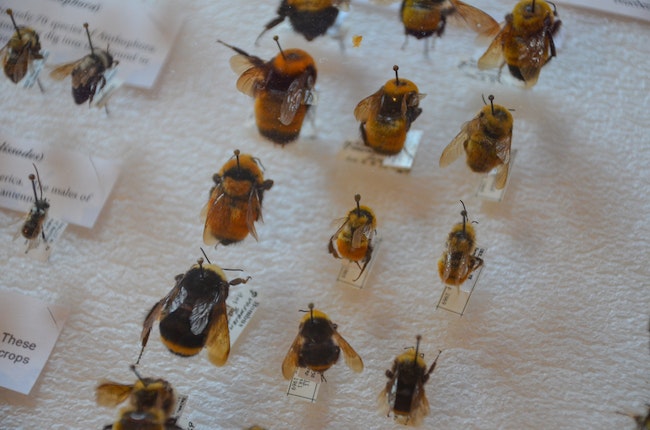 Bees collected by Oregon Bee Atlas volunteers on display at a Salem City Club lunch (Rachel Alexander/Salem Reporter)
Bees collected by Oregon Bee Atlas volunteers on display at a Salem City Club lunch (Rachel Alexander/Salem Reporter)
Salem City Club members are the newest recruits for one of the nation’s premier efforts to identify and track Oregon’s bee population.
About 80 people attended a club presentation Friday on state efforts to preserve the state’s pollinators and better track their health through the Oregon Bee Project, a unique collaboration between state agencies and Oregon State University extension services.
“Oregonians are absolutely fascinated with these bees,” said Andony Melathopoulos, an Oregon State University assistant professor specializing in pollinator health.
He appeared with Rose Kachadoorian, program manager for the state’s pesticide licensing program, outlining how Oregon came to have one of the most forward-thinking bee protection efforts in the U.S.
[ Help build Salem Reporter and local news – SUBSCRIBE ]
Oregonians’ interest in saving bees was kindled in 2014 after several highly-publicized bee deaths following the application of an insecticide on linden trees, Kachadoorian said. Some 50,000 bees died in a Target parking lot in Wilsonville, prompting public outcry.
“People ended up holding a funeral,” Kachadoorian said.
Regulators connected the deaths to the insecticide dinotefuran, which had been applied legally to the trees months earlier, Kachadoorian said. The deaths led to a temporary ban, then to permanent rules saying several insecticides should not be applied to linden trees or other species where bees are commonly found.
Those changes helped stop large die-offs of bees and sparked an interest in better monitoring of Oregon’s bee population and more efforts to improve their health.
In 2015, the Oregon Legislature required OSU and the state Department of Agriculture to develop an outreach program on pollinator health and best practices for pesticides. That effort, called the Oregon Bee Project, launched in 2017 and included the Oregon Department of Forestry.
The work includes classes for pesticide applicators to make sure they understand new requirements, and finding farms using bee-friendly practices to serve as models for other growers.
But they’ve also taken creative steps to get the public involved.
The largest is the Oregon Bee Atlas, a citizen scientist project that relies on volunteers around the state to “boldly go and find bees that no Oregonian has seen before.”
“We’ve appropriated the Star Trek theme,” Melathopoulos said, drawing a laugh from the crowd.
 Andony Melathopoulos, a leader of the Oregon Bee Project, speaks at a Salem City Club lunch (Rachel Alexander/Salem Reporter)
Andony Melathopoulos, a leader of the Oregon Bee Project, speaks at a Salem City Club lunch (Rachel Alexander/Salem Reporter)
Scientists believe Oregon is home to about 500 bee species, but there’s never been a statewide effort to document them or count their numbers. Without that data, it’s nearly impossible to tell if efforts to preserve bee populations are working.
Volunteers collect bee specimens and document native bees, sending data to scientists for analysis. Melathopoulos said their work has identified several species that not previously tracked in Oregon.
That collection has improved education efforts. Volunteers are encouraged to suggest funny or memorable names for the bees they find based on their initial impressions. Those names may make their way onto trading card-like handouts highlighting several bee species.
One bee was christened “Grumpbee” after Grumpy Cat, the dwarf cat with a perpetually frowning face who attained internet superstardom before passing away earlier this year.
On the day Grumpy Cat died, the Oregon Bee Project team affixed the name to a family of mining bees which nests in soil and has a similar-looking face.
 Education materials from the Oregon Bee Project emphasize memorable names (Rachel Alexander/Salem Reporter)
Education materials from the Oregon Bee Project emphasize memorable names (Rachel Alexander/Salem Reporter)
Their website includes information about the atlas, as well as resources for gardeners, farmers, educators, foresters and other groups of people looking to learn more about preserving bees.
City Club member Cindy Condon said she appreciated learning where gardeners can find information about helping bees.
“It’s hard for a gardener at home,” she said. “I want to do the right thing but I don’t know what the right thing is.”
Condon grows cucumber, pepper, eggplant and other vegetables in her home garden in west Salem. She’s now planting flowers to attract monarch butterflies and regularly sees bees visiting her plants.
She said she plant to sign up as a volunteer for the Bee Atlas and will keep an eye out for gardener-specific resources to help educate her neighbors.
“So many people in the home gardens go to the store, buy a pesticide and think it’s safe because it’s on the shelf,” she said.
This article was updated to clarify that state regulators permanently banned the use of several insecticides on linden trees and related species after a temporary ban in response to bee die-offs.
May we ask for just another minute of your time? Please complete this SURVEY with five questions that will take just a moment and provides us vital information to improve our service to Salem. Thank you!
Reporter Rachel Alexander: [email protected] or 503-575-1241.

Rachel Alexander is Salem Reporter’s managing editor. She joined Salem Reporter when it was founded in 2018 and covers city news, education, nonprofits and a little bit of everything else. She’s been a journalist in Oregon and Washington for a decade. Outside of work, she’s a skater and board member with Salem’s Cherry City Roller Derby and can often be found with her nose buried in a book.









